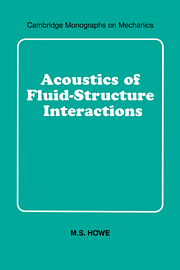5 - Interaction of sound with solid structures
Published online by Cambridge University Press: 22 March 2010
Summary
Fluid motion in the immediate vicinity of a solid surface is usually controlled by viscous stresses that cause an adjustment in the velocity to comply with the no-slip condition and by thermal gradients that similarly bring the temperatures of the solid and fluid to equality at the surface. At high Reynolds numbers, these adjustments occur across boundary layers whose thicknesses are much smaller than the other governing length scales of the motion. We have seen how the forced production of vorticity in boundary layers during convection of a “gust” past the edge of an airfoil can be modeled by application of the Kutta condition (Section 3.3). In this chapter, similar problems are discussed involving the generation of vorticity by sound impinging on both smooth surfaces and surfaces with sharp edges in the presence of flow. The aerodynamic sound generated by this vorticity augments the sound diffracted in the usual way by the surface. However, the near field kinetic energy of the vorticity is frequently derived wholly from the incident sound, so that unless the subsequent vortex motion is unstably coupled to the mean flow (acquiring additional kinetic energy from the mean stream as it evolves) there will usually be an overall decrease in the acoustic energy: The sound will be damped. General problems of this kind, including the influence of surface vibrations, are the subject of this chapter. We start with the simplest case of sound impinging on a plane wall.
Damping of Sound at a Smooth Wall
Dissipation in the Absence of Flow
The thermo-viscous attenuation of sound is greatly increased in the neighborhood of a solid boundary where temperature and velocity gradients are large.
- Type
- Chapter
- Information
- Acoustics of Fluid-Structure Interactions , pp. 317 - 430Publisher: Cambridge University PressPrint publication year: 1998



